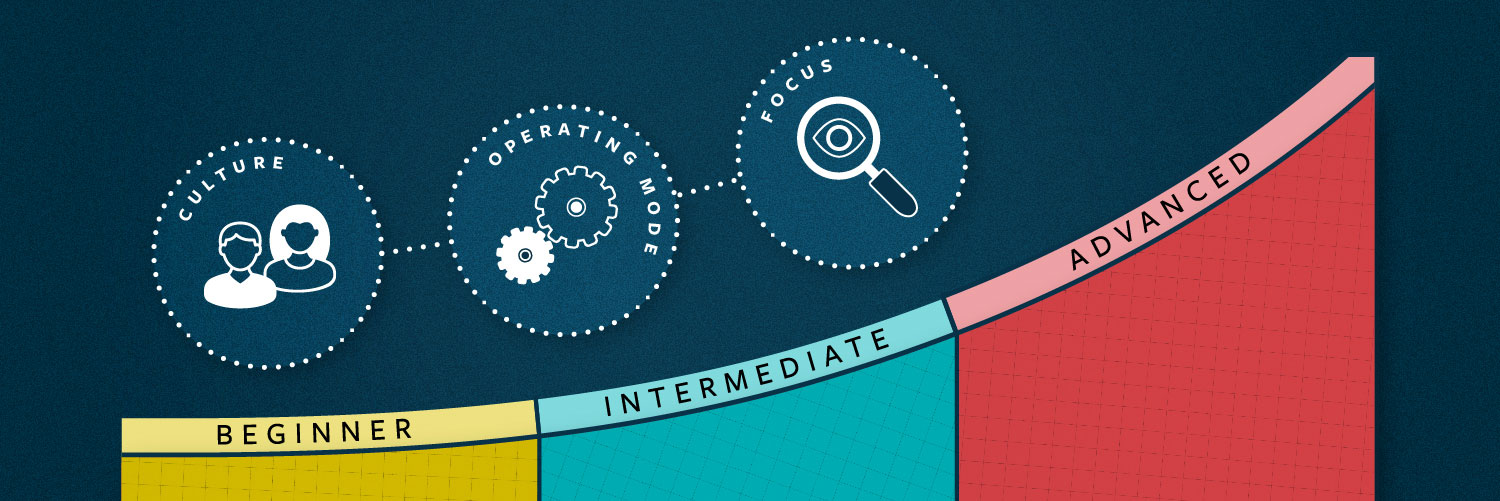
As humans, we are often compelled to compare ourselves or our work to what others are doing. When it comes to content strategy, many of us think that others are doing much more than we are. Thanks to research performed with associations, we now have a way to do some of that comparison.
In 2017, the American Society of Association Executives (ASAE) Foundation commissioned a research study to answer the question: How are associations managing the challenges and changes in how they create, facilitate, curate, and disseminate knowledge and learning through content?
For the next year, Dina Lewis, Hilary Marsh, and I conducted a literature review, two surveys, and a series of interviews to complete the largest research study to date about content strategy in the association industry. While this research uses associations as the subject, the findings apply more broadly to all types of organizations.
Associations have some unique challenges. These membership organizations have a primary focus of providing services and benefits to members of a specific group. They use content as a primary mechanism for providing value, and they produce a lot of content in support of their members. Member volunteers make decisions about topics and formats of content. Otherwise, they face all the same challenges of time, budget, human resources, and an ever-shifting environment as other types of organization. For all types of organizations, the stakes are high to approach content strategically.
Research Highlights
The full report, Association Content Strategies for a Changing World, was published in June 2019. All data used in this article come directly from the report.
For the purposes of the research, content strategy was defined as:
the planning and judgment for the creation, publication, dissemination, and governance of useful, usable, effective content across departments and functional areas.
While content strategy often focuses on websites or marketing content, content is substantive information produced and delivered using any medium. The research considered all types of content distributed or promoted across multiple channels.
The data collected in the research matches what the three of us had observed in our experiences with associations.
- Associations of all sizes and types practice content strategy. Neither staff size nor budget limit an organization’s ability to develop and implement a content strategy.
- Organizations create their own content strategy journeys. Content strategy tactics are applied based on pain points or according to which team drives the effort.
- Culture and leadership matter. Content strategy is ultimately about people. Without buy-in at all levels, content strategy efforts will not get very far.
- Common challenges have different approaches. Territoriality, alignment, and data threaten the implementation and ongoing success of any effort. Each organization has to find its own way through its particular challenges.
Now all of this is backed up with data that revealed patterns about what tactics organizations use, the role culture plays in content strategy adoption, and what approaches have worked.
The Nonprofit Association Content Strategy Maturity Model
The full report goes into depth about the state of content strategy in associations. What was most meaningful was the maturity model that emerged from the data. To find out who was doing content strategy, we asked survey participants to select all the content strategy tactics they were using. They had this list to choose from:
- Audience surveys
- Content audits
- Content governance
- Content model
- Digital content training
- Editorial style guide
- Job descriptions
- Journey maps
- Metadata strategy
- Monitor analytics
- Personas
- Planning calendar
- SEO strategy
- Stakeholder interviews
- Strategy statement
- Structured content
- Taxonomy
We had initially focused on the number of tactics survey respondents used to divide respondents into segments for conducting interviews. The goal was to talk to people who were doing only the minimum to be considered “practicing content strategy” as well as people who were doing more. For this purpose, we used beginning, intermediate, and advanced to define the groups.
Two rounds of interviews and another survey later, we put all our data and stories together and found that the number of tactics an organization used signified a maturity level.
There was no consistent set of tactics used by organizations at various levels. However, associations that deployed a similar number of individual tactics overall looked quite similar when it came to culture, operating mode, and focus. Thus, the Association Content Strategy Maturity Model was formed.
- Culture – how staff and other stakeholders interact to get content strategy work done
- Operating Mode – how content work gets spread throughout the organization
- Focus – scope of vision employed in executing the content strategy
Table 1: Association Content Strategy Maturity Model
| BEGINNING | INTERMEDIATE | ADVANCED | |
|---|---|---|---|
| CULTURE | Organic | Cooperative | Collaborative |
| Sustainability | Buy-in/Establish roles | Accountability | Integrated Outcome-focused |
| Mood/Mindset | Excitement Aspiration | Uncertainty | Confident Accomplishment |
| OPERATING MODE | Planning | Executing | Iterating |
| Scaling | One person or department | Multiple departments—creating alignment | Organization-wide—making dynamic connections |
| Optimizing | Tactics Establish metrics | Workflows Channels Analyze (Use) metrics | Process Data-driven |
| FOCUS | Tactics—starting something/getting started | New models Building bridges | Environment Outcomes |
©2019 ASAE Foundation
The maturity model shows that as an organization matures, it not only does more—it changes its culture, how it operates, and what it focuses on.
Organizations at the Beginning level focus on tactics. As the tactics get integrated into routines and roles, what matters more is how things work and how many people are involved. This shift may happen quickly. We found no common timeline for going from Beginner to Intermediate to Advanced. However, every organization has to start at the Beginner level. About a third—35%—were at the Beginning level.
Over half of the organizations we surveyed—55%—were at the Intermediate level. These organizations were a varied group. Some had accidentally ended up here through diligent work while others were deliberately moving forward with full support from their executives. All of the content strategy champions in these organizations recognized that they still had a long way to go to achieve their vision.
Only 10% are at the Advanced level. The hallmarks of organizations at this level go well beyond content strategy. They are integrated, transparent, collaborative, and outcome-based. To get to this level, organizational transformation needs to have occurred. Until the whole organization is set up to integrate content strategy practices into its operations, there are limits to what can be achieved.
The benefit of this research-based model is that it helps an organization define where it is now as well as a vision for the future. The research also indicated how organizations have successfully moved to a more mature state.
Use Research to Move Forward
When you know where you are and where you want to go, you can make a plan for getting there. Start where you are and take one step at a time to build momentum.
Identify maturity level
Start by collectively agreeing on where your organization is on the model. Different divisions in the organization may be at different points. For example, the marketing group may be at the Intermediate level in Focus but at the Advanced level in Operating Mode. Having everyone mark where they are on the model gives a picture of where the problems spots are as well as the points of light. When you know where you are in maturity, you can then make a plan for where you want to go.
Start in your own department
Where content strategy starts has a significant impact on how it progresses. Work with your strengths and acknowledge your challenges so that you can seek allies to overcome them.
The research found that the most common places an association content strategy practice starts is in the marketing (27%), education or professional development (18%), or communications (14%) department.
If you’re on a marketing team, you can start by shifting your focus on helping your colleagues achieve their goals. Doing so will give you more incentive to focus on broader outcomes rather than only campaign data.
Say there is a conference coming up in six months. Your instinct might be to make a calendar of tweets and Instagram posts and track likes until the conference is over. Meanwhile, the conference team has a goal of increasing attendance by 15% and revenue by 5% year over year for the next three years. How can the marketing team help the conference team meet its goals?
Start by ensuring the marketing goals are inline with conference goals and set up analytics to track conversions. Review analytics to see what channel is driving the most registrations. Perform analytics reviews regularly with the conference team so everyone can make adjustments based on what is happening. When you reach your goals, celebrate together! Be sure to share your success with the rest of the organization to spread the new ideas as well as bask in the limelight for a few minutes.
Education or professional development teams are responsible for helping professionals in an industry stay up-to-date and certified. There is a lot more that your organization does besides produce webinars that give continuing education credits. (An education or professional development department is fairly unique to associations due to being focused on supporting industry professionals.)
Let’s think about a new regulation that professionals in your industry need to follow starting in three months. Your team probably starts by setting up a webinar, for which attendees will get continuing education credit they need to stay licensed.
But what else could members use to get up to date on this regulation and the topic it is about?
There are also books, journals, newsletters, magazines, conferences and volunteer opportunities that keep people informed about the industry and involved with professional development. This means working with your colleagues in all the other departments that produce content to curate appropriate content that is useful to your members.
Now you work with the web team to make space on the website to get all of this information by topic. You can point people to the webinar as well as a whole set of information that will help them be able to make the transition smoothly. Even better, once this curation happens once, it’s easy to repeat.
Set a goal around the curation. Maybe you can increase attendance on the webinar as well as the purchase of books and email newsletter subscriptions. And the email newsletter has a goal of increased click-through rates, which leads to longer time on the website and more conversions to volunteer sign-ups. Congratulations! You have now increased the value of membership. That should show up in improved retention numbers, which is a goal of the membership department.
Communications teams know what topics are hot, especially for audiences beyond the prospects and customers. Spreading the organization’s message in a clear, concise, and consistent manner is your goal. You need help from other teams to do that.
Let’s say there has been a national news story your organization has the expertise to respond to. Of course you will issue a press release, post a response on social media, and offer your executives to the media. All of those things are fairly short statements that need deeper information to back them up. People are going to go to your website next.
Gather your subject matter experts to find out what else you have on the topic. Include the web team so the topic can be easily found from the home page or any other page where you expect people to land after searching for the topic. You need one of those topic pages like the education department has now. It can point to whatever content your experts think people will be looking for.
If this is going to be a long-term problem, your colleagues in other departments may want to create programs, services, and events that fill a new need. In that case, you’ll want to work with the marketing team to create a new segment for your email list so you can allow people to sign up when more information is available. (Do not take the opportunity to add people to your main list, let them opt-in separately!)
Continue to collaborate on what is happening and when things are created. You had not planned on it, but now you have new people who are aware of what you do and how you have helped them in a time of need. Cheers! Keep up the work to nurture this new relationship.
Whatever your department and whatever your role, there is something you can do to move towards a more strategic and sophisticated approach to content. Set your sights at a realistic target and don’t be afraid to fail.
Experiments and pilot projects within your team or with a willing ally will allow you to test assumptions and see what works at a small scale.
Address biggest pain points
Maybe you’ve taken the lead or been given responsibility to get this content strategy thing in gear. Start by solving problems that are obvious and will provide others with needed relief. During the research, we found some common problems and some ways to address them.
Inability to prioritize content
When everything is important, nothing is important. The best way to prioritize is to start from a point of agreement: your audience’s needs. When you focus on your audience, internal opinions matter less. Not sure what your audience needs? Try one or more of these tactics to learn what they are and document them.
- Survey your audience to understand their priorities and challenges. Make sure to define what you want to learn and do research to create good survey questions.
- Create audience personas or customer journeys. Go beyond demographics to include different segments based on information needs.
- Conduct stakeholder interviews to understand the goals of your colleagues. Be sure to share the synthesized results. You will gain good insights about how aligned people are—for good or ill.
Lack of content alignment
Silos are strong in many organizations, which means each department may have goals that conflict or compete with other departments. People can get protective of their content. To progress beyond the Intermediate level, all departments must be aligned around the organization’s strategic goals as well as the audience needs. To foster a collaborative environment and create lasting connections, start or work on ways to integrate content into everyday work.
- Include content responsibilities in job descriptions for anyone who is responsible for content. Make their role in content strategy explicit and do not leave it to “other duties as assigned.”
- Create an organization-wide content strategy statement with a cross-departmental, management-level group. This will be the guiding star for everyone.
- Create a content model and use your content management system to publish content in a more structured way so that content can be dynamic. This is especially helpful when it comes to curation.
- Plan content with an organization-wide content calendar.
Inability to make data-driven decisions
Like the focus on audience needs, having data to inform decisions is much more strategic than relying on opinions or hunches. Data provides a starting point for better communication around content. Do not base decisions on data alone, but it is a much better place to start than someone’s gut instinct.
- Enable content goals to be measured using digital analytics tools. Every piece of content published should have measurable goals attached to it.
- Apply metrics to support decisions of future content, including topics, types, timing, and channels. Make the content you create have value.
- Establish content governance policies that set out roles, responsibilities, success criteria, and how to make decisions.
There are plenty of other pain points you might be experiencing. The key is identifying and prioritizing them. Then take a look at the list of tactics and see what will help you solve them.
Events, Resources, + More
Workshop: Are You Ready for AI?
Is your organization really ready for AI at scale? Let the Content Science team guide your leaders through assessing 4 areas of readiness.
Course: Prompting Text Generative AI
Learn how to bring out the full potential of text generative AI to create impactful content from this on-demand course.
Webinar: Benchmarks for Content Effectiveness
It's not about more content. It's about more effective content. Gain tips based on Content Science's unique research + experience.
The Ultimate Guide to End-to-End Content
Discover why + how an end-to-end approach is critical in the age of AI with this comprehensive white paper.






Comments
We invite you to share your perspective in a constructive way. To comment, please sign in or register. Our moderating team will review all comments and may edit them for clarity. Our team also may delete comments that are off-topic or disrespectful. All postings become the property of
Content Science Review.